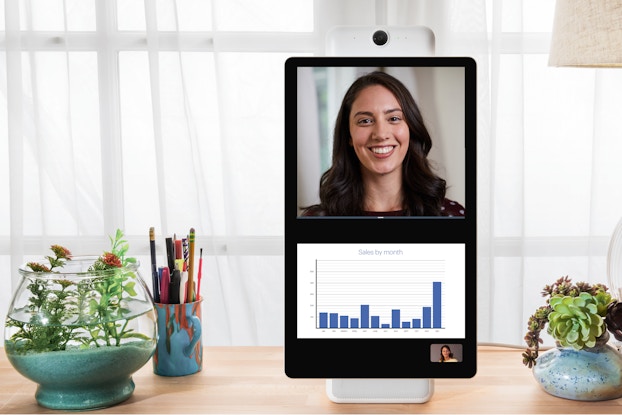
If you spend most of your workday sitting at a desk in front of a computer, chances are you use a variety of tools and platforms to communicate with your colleagues, managers and clients. But what if you don’t ever sit down, much less have access to a computer, for the tasks you need to accomplish?
That’s the case for about 24 million workers in the U.S. alone — who range from bank tellers to restaurant servers and flight attendants to retail cashiers — according to data from the Institute for Corporate Productivity and the Aspen Institute’s Upskill America.
Their joint report defines these employees as frontline workers without a four-year college degree, who typically earn less than $40,000 per year. And Facebook saw this group as its ticket to capturing a part of the lucrative, global team collaboration software market (think Slack), valued at $8.19 billion in 2017 and estimated to grow 9% through 2025, according to a recent Grandview Research report.
That’s just what Facebook is aiming for with its Workplace collaboration platform, which just crossed the threshold of three million paid users — up more than one million in the last eight months.
Christine Trodella, Workplace by Facebook’s head of Americas, illustrated the mobile platform’s rapid rate of adoption by describing an all-too-common workplace scenario, of how a group of sales associates (or warehouse pickers, or baristas) would have to gather around a photocopied bulletin in a break room to read announcements of upcoming schedules or other important company news. There was no way to immediately communicate with managers or other workers who weren’t present. Supervisors just had to hope everyone got the message, she said at a recent press dinner attended by CO—.
So, in 2016, the social networking giant launched Workplace by Facebook, a platform aimed at connecting huge swaths of the workforce that hadn’t had a digital solution to date.

A multi-industry tool, with clients from Starbucks to Spotify
Workplace originated as an internal tool for Facebook employees, but was broadened to serve the needs of companies who had both knowledge workers (those who have access to computers) and their frontline counterparts. The platform now has customers in nearly every industry, including Walmart, Starbucks, Spotify, WW, AstraZeneca and Deliveroo, and recently announced a batch of new features to further assist its rapidly growing customer base.
Workplace operates completely independently of Facebook — you can’t access it through your existing profile, you need a separate work login and there is no crossover. However, the social network’s familiar blue design remains, as do features like chat, video calling, posts and groups. This is intentional, as most people, regardless of the kind of work they do, understand how to use Facebook, so the learning curve isn’t steep.
Workplace has managed to grow despite the long shadow of its parent, based on the strength of its features. At Delta Airlines, for example, all 80,000 employees worldwide have had access to Workplace since last year. Catherine Simmons, who oversees employee communications channel strategy and internal social media at Delta, told CO— that the company uses it for broadcasting information to Delta employees worldwide and to specific, targeted groups; to allow for two-way communication and recognition among peers and leaders; as a collaboration tool to allow teams to form working groups; and as a chat tool, where employees are able to direct message or voice/video call coworkers through their desktop or Workplace Chat.
We want to be the first communication and collaboration platform to connect everyone who's employed, regardless of where or how they work.Christine Trodella, head of Americas, Workplace by Facebook
Connect
Facebook found a way to uniquely identify itself within the team collaboration software market, connecting employees with each other. Read on for more useful collaboration apps.
“We’ve found that Workplace by Facebook is particularly valued by our international employees, as it allows them to interact, engage and connect with their colleagues worldwide,” said Simmons. “We’ve also seen value in capabilities like the Safety Check, where we are able to check-in with employees across the globe and proactively ask for responses from select groups,” she added. Other tools, such as the Mark, enable managers to ensure employees are seeing critical information like a deadline for a project. The mobile app has also been valuable for employees who don’t sit at a desk.
Adding voice and video to the mix
To facilitate even more interactive communication, Workplace just rolled out a host of new features at the company’s recent Flow annual conference on culture, technology and people. Workplace on Portal, for example, is a new app that allows Workplace users to make voice and video calls through Portal, the company’s AI-powered smart camera. That means that no matter where the person speaking is situated in a given space, the camera will move toward them so they are in frame and can be heard.
Automatic video captioning allows users to add captions to posted videos for those workers who may be hearing-impaired or frontline workers who may not have sound turned on while watching in the app.
There are also features that facilitate onboarding and learning, such as a new type of post that allows group administrators to create, label and curate learning content, including best practices. There are surveys, a new option to access Workplace for those without a company email address and an analytics platform for administrators to identify “engaged users” and get sentiment analysis for anything a user posts through Workplace’s AI. To help teams and individual employees feel even more connected, Workplace added tools to set goals, give thanks, and offer badges to recognize achievement.
Although there are plenty of collaboration tools out there, namely Slack, Cisco Spark, Microsoft Teams and IBM Watson, Workplace’s Trodella maintained that those organizations built their software as a service (SaaS) business in a uniform way. “We intentionally built the Workplace business differently,” she explained, “focusing on the largest enterprises in the world first, connecting everyone in a company and earning our credibility. We started by winning the Fortune 500 (including the Fortune 1) and now we are going down the market,” Trodella said.

Workplace generates its revenue through a tiered subscription model, which is free for the most basic tools and rises to $4 and $8 per person per month for advanced and enterprise users. This is lower than one of its closest competitors, Slack, which charges $8 and $15 per person per month.
But competition may not be as big a threat to Workplace as the potential for decreasing workers’ productivity. A recent report from Workfront indicated that meetings and emails are most workers' primary hindrances to doing their jobs.
Yet David K. Johnson, principal analyst, serving chief information officers at Forrester, argued that giving frontline employees the ability to communicate with others is worth the time commitment. “It gives employees the opportunity to feel seen and heard by others in ways that they couldn’t be before,” Johnson told CO—. “They can contribute ideas, energy, passion, enthusiasm, and that will go to a wider audience than ever before,” he said, “And they can also be much more aware of what’s most important for them to focus on.”
As Trodella sees it, “We want to be the first communication and collaboration platform to connect everyone who's employed, regardless of where or how they work — particularly those who don’t have a desk, a PC or email address, who we know represent 80% of the global workforce and are an important part of the future of work.”
CO— aims to bring you inspiration from leading respected experts. However, before making any business decision, you should consult a professional who can advise you based on your individual situation.
Want to read more? Be sure to follow us on LinkedIn!
CO—is committed to helping you start, run and grow your small business. Learn more about the benefits of small business membership in the U.S. Chamber of Commerce, here.









